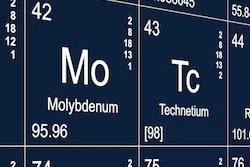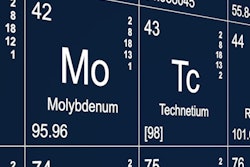
Supplies of a key radioisotope used in nuclear cardiology scans could be disrupted next month when a Canadian nuclear reactor begins shutting down. U.S. healthcare providers could be left scrambling for new sources of molybdenum-99 (Mo-99) until other suppliers are able to step in and fill the void.
That's according to the National Academies of Sciences, Engineering, and Medicine (NAS), which in a new report predicts a greater than 50% likelihood of a "severe" global medical isotope shortage as Canadian Nuclear Laboratories (CNL) ceases routine production of Mo-99 next month at its National Research Universal (NRU) reactor in Chalk River, Ontario.
The new report also forewarned that European suppliers' projects to convert Mo-99 production to low-enriched uranium could further exacerbate the Mo-99 shortage in 2017 and 2018. In many ways, the NAS forecast is a best-case scenario predicated on Mo-99 suppliers completing their projects on time with no startup delays.
To help alleviate the potential isotope shortfall, the NAS recommended that the U.S. government "continue to work with the Canadian government to ensure that there is an executable and well-communicated plan in place to restart Canadian supply of molybdenum-99 after October 2016."
CNL reactor plans
CNL plans to keep the NRU reactor on "hot standby" beyond next month as the facility is considered a "supplier of last resort" until the end of March 2018, according to the report. After that date, CNL will permanently shut down the reactor, which is now 58 years old.
As of this past June, approximately 95% of the global Mo-99 supply is produced at seven research reactors located in Australia, Canada, Europe, and South Africa. The other 5% is produced at other facilities for regional use.
The shuttering of the NRU reactor reduces to six the number of irradiation-services suppliers producing Mo-99, which is the raw material for technetium-99m (Tc-99m), a widely used radiopharmaceutical for nuclear cardiology and other studies. Four of those reactors are more than 50 years old. Several of the reactors have experienced unscheduled downtime for major repairs, and the NAS report stated there is "no reason to believe that such outages will not occur in the future."
The NRU reactor's closure also reduces the number of global Mo-99 suppliers from five to four, with three of the suppliers -- the Australian Nuclear Science and Technology Organization (ANSTO), the Institute for Radioelements (IRE) in Belgium, and Mallinckrodt -- currently undertaking substantial modifications to their facilities or processes.
Waiting in the wings are NTP Radioisotopes in South Africa, which has initiated plans to expand its available supply capacities, and the Russian Federation, which wants to become a global Mo-99 supplier.
U.S. production
Currently, there are two projects underway to begin Mo-99 production in the U.S.:
- Shine Medical Technologies is working to build a medical isotope manufacturing facility in Janesville, WI.
- NorthStar Medical Radioisotopes and General Atomics have begun routine production of Mo-99 at the University of Missouri Research Reactor in Columbia, MO.
"However, no domestic commercial production will be established before Canada stops producing molybdenum-99 after October 2016," according to the report. "Potential domestic molybdenum-99 suppliers face technical, financial, regulatory, and market penetration challenges. The market challenges will likely increase after current global suppliers expand production."
If and when global production ventures come online, the NAS estimated they would add approximately 4,400 six-day Ci per week of available supply capacity. That contribution would offset the loss of 4,680 six-day Ci per week of available supply when the NRU reactor ramps down next month.
The burden of an Mo-99 shortage may be lessened if U.S. demand for Mo-99 and technetium-99m for medical use continues to decline, as it has for the past decade. The average decrease in U.S. Mo-99 and Tc-99m utilization from 2009-2010 to 2014-2015 was approximately 25%, according to the NAS, which found it "unlikely that domestic demand will increase significantly over the next five years."
In the international arena, however, the NAS predicted that demand for Mo-99 will escalate over the next five years due to greater utilization in emerging Asian markets.
SNMMI reaction
The president of the Society of Nuclear Medicine and Molecular Imaging (SNMMI), Sally Schwarz, concurred with the report's conclusions.
"Development of these new, nonhighly enriched uranium production methods is costly, even when shared with governments," said the professor of radiology at Washington University School of Medicine in St. Louis in a prepared statement. "It will take time and incremental changes to reach a balance point of fair reimbursement for increased costs for all members of the supply chain including Mo-99 producers, generator manufacturers, nuclear pharmacies, hospitals, and patients."
She cautioned that while the potential for short-term shortages is a concern, she is confident global Mo-99 producers, processors, and generator manufacturers will collaborate with the Association of Imaging Producers and Equipment Suppliers to manage any interim shortages.
"The innovative, safer production methods and facilities that will be coming online over the next few years will certainly help ensure a safe, reliable supply of Mo-99," Schwarz said.




















